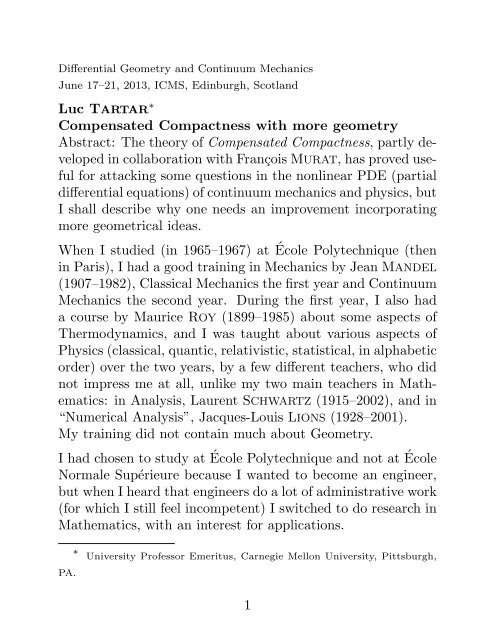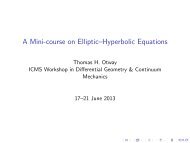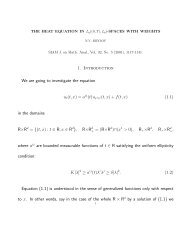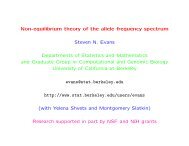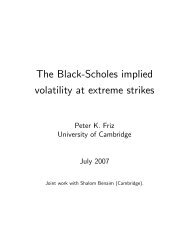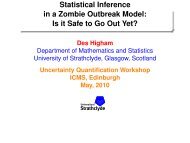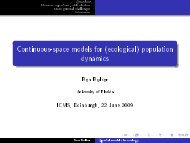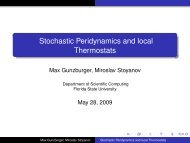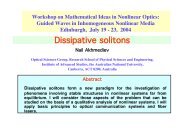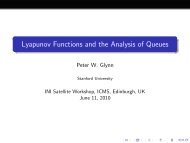Luc TARTAR Compensated Compactness with more ... - ICMS
Luc TARTAR Compensated Compactness with more ... - ICMS
Luc TARTAR Compensated Compactness with more ... - ICMS
Create successful ePaper yourself
Turn your PDF publications into a flip-book with our unique Google optimized e-Paper software.
Differential Geometry and Continuum Mechanics<br />
June 17–21, 2013, <strong>ICMS</strong>, Edinburgh, Scotland<br />
<strong>Luc</strong> <strong>TARTAR</strong> ∗<br />
<strong>Compensated</strong> <strong>Compactness</strong> <strong>with</strong> <strong>more</strong> geometry<br />
Abstract: The theory of <strong>Compensated</strong> <strong>Compactness</strong>, partly developed<br />
in collaboration <strong>with</strong> François MURAT, has proved useful<br />
for attacking some questions in the nonlinear PDE (partial<br />
differential equations) of continuum mechanics and physics, but<br />
I shall describe why one needs an improvement incorporating<br />
<strong>more</strong> geometrical ideas.<br />
When I studied (in 1965–1967) at École Polytechnique (then<br />
in Paris), I had a good training in Mechanics by Jean MANDEL<br />
(1907–1982), Classical Mechanics the first year and Continuum<br />
Mechanics the second year. During the first year, I also had<br />
a course by Maurice ROY (1899–1985) about some aspects of<br />
Thermodynamics, and I was taught about various aspects of<br />
Physics (classical, quantic, relativistic, statistical, in alphabetic<br />
order) over the two years, by a few different teachers, who did<br />
not impress me at all, unlike my two main teachers in Mathematics:<br />
in Analysis, Laurent SCHWARTZ (1915–2002), and in<br />
“Numerical Analysis”, Jacques-Louis LIONS (1928–2001).<br />
My training did not contain much about Geometry.<br />
I had chosen to study at École Polytechnique and not at École<br />
Normale Supérieure because I wanted to become an engineer,<br />
but when I heard that engineers do a lot of administrative work<br />
(for which I still feel incompetent) I switched to do research in<br />
Mathematics, <strong>with</strong> an interest for applications.<br />
∗<br />
PA.<br />
University Professor Emeritus, Carnegie Mellon University, Pittsburgh,<br />
1
I chose Jacques-Louis LIONS as thesis advisor (since he looked<br />
<strong>more</strong> interested in applications than Laurent SCHWARTZ), but<br />
when (in the mid 1970s) I decided to understand <strong>more</strong> about<br />
Continuum Mechanics for developing some of the new mathematical<br />
tools needed, it appeared that he was not interested.<br />
Although his Theory of Distributions helped understand formal<br />
results by HEAVISIDE (1850–1925) and by DIRAC (1902–1984),<br />
Laurent SCHWARTZ had no interest in Physics.<br />
I think that Sergei SOBOLEV (1908–1989) introduced his H 1<br />
space in relation to a physical question; that he did not publish<br />
<strong>more</strong> about his theory seems related to USSR politics.<br />
It was in relation to (simplified) Navier–Stokes equation that<br />
Jean LERAY (1906–1998) used weak solutions, but he stopped<br />
working on PDE in Continuum Mechanics when he was a prisoner<br />
of war during World War II.<br />
The approach which I was taught for nonlinear PDE, of introducing<br />
adapted Sobolev spaces and proving various estimates<br />
for showing existence and uniqueness of solutions used either<br />
a compactness argument, according to the original ideas of<br />
Jean LERAY, or a monotonicity argument, introduced by Eduardo<br />
ZARANTONELLO (1918–2010) for a problem in Fluid Dynamics,<br />
and by George MINTY (1930–1986) for a problem in<br />
Electricity; while I was a student, monotonicity then developed<br />
into a question of Functional Analysis, mostly studied<br />
by Haïm BREZIS, Felix BROWDER, Jacques-Louis LIONS, and<br />
Terry ROCKAFELLAR (in alphabetic order).<br />
I unified these various aspects in my <strong>Compensated</strong> <strong>Compactness</strong><br />
Method, based on my joint work in <strong>Compensated</strong> <strong>Compactness</strong><br />
<strong>with</strong> François MURAT.<br />
2
In the late 1960s, a student at École Polytechnique from the<br />
year after mine told me that I should read Foundations of Mechanics<br />
by ABRAHAM: I bought the book and it was useful<br />
since it contained plenty of results about manifolds, which I<br />
had only heard about in a vague way, but I ended up quite<br />
puzzled, because the book contained no Mechanics at all!<br />
I realized afterward that it is common for differential geometers<br />
to be stuck at the 18th century point of view of Mechanics<br />
(Classical Mechanics) which uses ODE (ordinary differential<br />
equations), as if they were not bright enough to learn the 19th<br />
century point of view of Mechanics (Continuum Mechanics)<br />
which uses PDE.<br />
Of course, I observed a similar limitation when I later explained<br />
that the 20th century point of view of Mechanics/Physics uses<br />
PDE <strong>with</strong> small scales, so that one needs to understand questions<br />
of Homogenization for identifying limiting effective equations,<br />
which often force to consider a larger class of equations<br />
(still a little vague) which I call beyond PDE.<br />
A little later (still in the late 1960s) a friend told me about the<br />
ideas of René THOM (1923–2002), whose book I only glanced at<br />
since he seemed to believe that the laws governing Nature are<br />
ODE, again the 18th century point of view, as if he decided to<br />
ignore the 19th century point of view of PDE. I also was puzzled<br />
<strong>with</strong> his choice of the term “catastrophes” for “singularities of<br />
differentiable mappings”.<br />
In 1970, I was shown an article by David EBIN and Jerry<br />
MARSDEN (1942–2010), on Euler equation for an incompressible<br />
fluid on a compact Riemannian manifold, based on an idea<br />
of Vladimir ARNOL’D (1937–2010), of considering a flow of volume<br />
preserving diffeomorphisms.<br />
3
I was puzzled that they considered a not so realistic EOS (equation<br />
of state), since incompressibility implies an infinite speed<br />
of sound, <strong>with</strong>out saying what to do for a realistic situation,<br />
of a (compressible) fluid occupying a domain Ω ⊂ R 3 having a<br />
boundary (while compact manifolds have no boundary)!<br />
Thirty years after I was again puzzled that for writing the<br />
questions for the million dollar Clay Prize on Navier–Stokes<br />
equation, Charles FEFFERMAN could not find (in Princeton<br />
or elsewhere) a knowledgeable person (mathematician or not)<br />
who could tell him what the equation is about: he should have<br />
mentioned the basic conservation laws of Continuum Mechanics<br />
and explained why he did not use the conservation of energy;<br />
among the groups of invariance of the equation he should have<br />
mentioned the invariance by rotation (since one considers an<br />
isotropic fluid) and Galilean invariance; in selecting cases <strong>with</strong>out<br />
boundary (R 3 or a flat torus) he should have mentioned<br />
that realistic domains have a boundary, and because bounding<br />
the vorticity is the main difficulty for proving global existence<br />
of smooth solutions, he should have mentioned the importance<br />
of the boundary, since it seems that vorticity is created there.<br />
In 1970, I first read about covariant derivatives, used for writing<br />
Navier–Stokes equation on a Riemannian manifold, but<br />
later I wondered why geometers think it is a good way to<br />
write such equations: is their framework useful for <strong>more</strong> general<br />
EOS For example, realistic fluids have their viscosity depending<br />
upon temperature, maybe also upon pressure.<br />
Geometers (and later harmonic analysts) seemed to think that<br />
they were doing a useful job in writing equations of Continuum<br />
Mechanics in their language, but has it led to a natural way of<br />
obtaining a priori estimates for flows of realistic fluids<br />
4
Has their framework been useful for understanding which effective<br />
equations to use for turbulent flows<br />
That turbulence is a (still unsolved) question of Homogenization<br />
only became clear to me in the late 1970s, but before considering<br />
transport equations, a first step had been to develop<br />
the theory of Homogenization for V -elliptic equations, which<br />
François MURAT and I (re)discovered in the early 1970s, defining<br />
H-convergence: the framework of G-convergence was already<br />
developed in the late 1960s in Pisa, by Sergio SPAGNOLO,<br />
Ennio DEGIORGI (1928–1996), and Antonio MARINO. We followed<br />
a different argument, based on our div-curl lemma, instead<br />
of regularity results in the style of MORREY (1907–1980).<br />
All this had been exercises in Functional Analysis and variational<br />
V-elliptic equations in subspaces of H 1 (Ω) <strong>with</strong> Ω ⊂ R N ,<br />
in the spirit of what we learned from our advisor, and it was the<br />
work of Évariste SANCHEZ-PALENCIA (for periodic microstructures)<br />
which made me understand that what we had done is<br />
related to the notion of effective properties of mixtures.<br />
This observation gave me (at last) a mathematical way for<br />
understanding if a few results which I had been taught in Continuum<br />
Mechanics or Physics were correct: since some well<br />
accepted ideas are flawed, it naturally led me to try to put<br />
some order in the various physical models which are used, and<br />
investigate what <strong>more</strong> realistic models should look like.<br />
As was shown to me by Joel ROBBIN, our (1974) div-curl<br />
lemma (found in checking when we could compute an effective/homogenized<br />
diffusion tensor) has a simple geometric interpretation<br />
using the language of differential forms, developed<br />
by E. CARTAN (1869–1951), and POINCARÉ (1854–1912).<br />
5
In an open set Ω ⊂ R N , one considers two sequences converging<br />
weakly in L 2 loc (Ω; CN ), E (n) ⇀ E (∞) , D (n) ⇀ D (∞) , and one<br />
assumes that E (n) has a good curl in the sense that each component<br />
∂E(n) j<br />
∂x k<br />
− ∂E(n) k<br />
∂x j<br />
stays in a compact of H −1<br />
loc<br />
(Ω) strong, and<br />
∂D (n)<br />
j<br />
∂x j<br />
that D (n) has a good div in the sense that ∑ j<br />
stays in a<br />
compact of H −1<br />
loc (Ω) strong. It implies that e(n) = (E (n) , D (n) )<br />
(i.e.<br />
∑j E(n) j D (n)<br />
j ) converges to e (∞) = (E (∞) , D (∞) ) weakly<br />
in the sense of Radon measures (test functions in C c (Ω)).<br />
I constructed a counter-example for showing that convergence<br />
may not hold in L 1 loc (Ω) weak (test functions in L∞ c (Ω)), but<br />
this discrepancy does not appear in Homogenization (of a stationary<br />
diffusion equation).<br />
Our proof uses Fourier transform and Plancherel formula, and<br />
follows an argument of Lars HÖRMANDER for showing the<br />
Rellich–Kondrašov compact injection of Hloc 1 (Ω) into L2 loc (Ω)<br />
(my advisor taught a different proof, <strong>with</strong> an argument of<br />
KOLMOGOROV (1903–1987), and also FRÉCHET (1878–1973)).<br />
At the beginning of the academic year 1974/75, which I spent<br />
at UW (University of Wisconsin) in Madison, Joel ROBBIN<br />
showed me an alternate proof of the div-curl lemma valid on<br />
(Riemannian) manifolds: it uses Hodge decomposition, considering<br />
E n as components of a 1-form, D n as components of an<br />
(N − 1)-form, and the wedge product of these two forms.<br />
In the new approach which I was developing, the weak limit<br />
is a way to define macroscopic quantities: E (n) is like a real<br />
electric field <strong>with</strong> variations at a mesoscopic level and E (∞) is<br />
like the macroscopic value. The div-curl lemma then implies<br />
that in Electrostatics there is no need for an internal energy.<br />
6
However, for a scalar wave equation, the div-curl lemma implies<br />
an equipartition of (hidden) energy, which I consider <strong>more</strong><br />
physical than what my physics teachers taught. If u n satisfies<br />
∂<br />
(<br />
ρ ∂u )<br />
n<br />
− ∑ ∂t ∂t<br />
j,k<br />
∂<br />
(<br />
∂u<br />
)<br />
n<br />
A j,k<br />
∂x j ∂x k<br />
= 0,<br />
<strong>with</strong> the usual hypothesis (ρ, A j,k only depending upon x and<br />
L ∞ , ρ ≥ α > 0, A ≥ α I symmetric), there is a conservation<br />
law for total energy, whose density<br />
e n = 1 2 ρ ∣ ∣∣ ∂u n<br />
∂t<br />
∣ 2 + 1 2<br />
∑<br />
j,k<br />
is the sum of a kinetic part 1 2 ρ ∣ ∂u n<br />
∑<br />
∂t<br />
1<br />
2 j,k A j,k ∂u n ∂u n<br />
∂x j ∂x k<br />
.<br />
If u n converges weakly to 0 in Hloc 1<br />
A j,k<br />
∂u n<br />
∂x j<br />
∣ 2<br />
∂u n<br />
∂x k<br />
and a potential part<br />
(in (x, t)), it is not always<br />
true that e n converges weakly to 0, because there is the possibility<br />
to hide some energy at various mesoscopic levels, but<br />
there is an equipartition between the hidden kinetic part of the<br />
energy and the hidden potential part of the energy, because the<br />
action a n converges weakly to 0, <strong>with</strong><br />
a n = 1 2 ρ ∣ ∣∣ ∂u n<br />
∂t<br />
∣ 2 − 1 2<br />
∑<br />
j,k<br />
A j,k<br />
∂u n<br />
∂x j<br />
∂u n<br />
∂x k<br />
.<br />
In Electromagnetism, there is a similar equipartition of hidden<br />
energy, between the electric part and the magnetic part of the<br />
energy, but there is something <strong>more</strong> to discuss beyond that.<br />
7
A native of Edinburgh, CLERK-MAXWELL (1831–1879) was a<br />
great physicist, and if I call Maxwell–Heaviside equation what<br />
others call the Maxwell equation, it never was my intention to<br />
rob him of any of his ideas, but to thank HEAVISIDE too, for<br />
deducing the concise system of PDE which one uses now, since<br />
the complicated system written by MAXWELL was encumbered<br />
<strong>with</strong> old mechanistic ideas concerning aether.<br />
The Maxwell–Heaviside equation uses four “vector” fields, E<br />
(electric field), H (magnetic field), D (electric polarization),<br />
and B (magnetic induction), satisfying<br />
div(D) = ρ, ∂D<br />
∂t<br />
− curl(H) = j,<br />
which imply the conservation of electric charge<br />
∂ρ<br />
∂t<br />
+ div(j) = 0,<br />
and<br />
which imply<br />
div(B) = 0, ∂B<br />
∂t<br />
+ curl(E) = 0,<br />
B = −curl(A), E = −grad(V ) + ∂A<br />
∂t ,<br />
for a scalar potential V and a vector potential A, defined up to<br />
a gauge transform<br />
V + ∂ψ<br />
∂t , A + grad(ψ).<br />
8
If one applies to the Maxwell–Heaviside equation the compensated<br />
compactness theorem (an improvement of the div-curl<br />
lemma done <strong>with</strong> François MURAT in 1976), one deduces that<br />
if sequences B (n) , D (n) , E (n) , H (n) converge weakly to 0 and<br />
correspond to ρ (n) and j (n) having components in a compact<br />
of H −1<br />
loc<br />
strong, then 3 linearly independent quadratic quantities<br />
converge weakly to 0,<br />
(D (n) , H (n) ); (B (n) , E (n) ); (D (n) , E (n) ) − (B (n) , H (n) ).<br />
Again, Joel ROBBIN explained to me these facts using differential<br />
forms: the conservation of charge means that a 3-form<br />
(in space-time) ω 3 (<strong>with</strong> components ρ and j) is exact, hence<br />
by Poincaré’s lemma ω 3 = dω 2 for a 2-form ω 2 (having D and<br />
H as components); there is another 2-form ˜ω 2 (having B and<br />
E as components) which is exact, hence by Poincaré’s lemma<br />
˜ω 2 = dω 1 for a 1-form ω 1 (having V and A as components),<br />
and of course this 1-form is defined up to an exact 1-form dψ.<br />
One can make the 3 quadratic quantities appear by considering<br />
the wedge-products ω 2 ∧ ω 2 , ˜ω 2 ∧ ˜ω 2 , ˜ω 2 ∧ ω 2 , and the only<br />
coefficient of these 4-forms are (D, H), (E, B), (D, E)−(B, H).<br />
Of course, the compensated compactness theorem implies that<br />
if α (n) is a sequence of p-form converging weakly to α (∞) (in<br />
L 2 loc ), if β(n) is a sequence of q-form converging weakly to β (∞) ,<br />
<strong>with</strong> p + q ≤ N, and if the exterior derivatives dα (n) and dβ (n)<br />
have their coefficients in a compact of H −1<br />
loc strong, then α(n) ∧<br />
β (n) converges weakly to α (∞) ∧ β (∞) .<br />
The approach of Joel ROBBIN using Hodge theory in the case<br />
of differential forms corresponds to variable coefficients.<br />
9
The (1976) compensated compactness theorem could only handle<br />
differential equations <strong>with</strong> constant coefficients, but the<br />
generalization of H-measures which I developed in the late<br />
1980s can handle variable (smooth enough) coefficients.<br />
The result shown is independent of the constitutive relations<br />
between the four “vector” fields; one usually assumes that<br />
D = ε E, B = µ H<br />
where the dielectric permittivity ε and the magnetic susceptibility<br />
µ are symmetric positive definite tensors, and then one<br />
has conservation of (total) energy, whose density is<br />
e = 1 2 (D, E) + 1 2<br />
(B, H).<br />
The equipartition of (hidden) energy (between electric and<br />
magnetic parts) means that the excess in the limit of the electric<br />
part 1 2<br />
(D, E) and the excess in the limit of the magnetic<br />
part 1 2<br />
(B, H) are equal: by passing to the limit in the action<br />
a = 1 2 (D, E) − 1 2<br />
(B, H).<br />
For scalar ε and µ, the velocity of light v (in any direction)<br />
satisfies ε µ v 2 = 1, ε 0 µ 0 c 2 = 1 for the vacuum, and the scalar<br />
index of refraction n (≥ 1) is defined by v = c n .<br />
NEWTON (1643–1727) observed that a prism splits colours differently:<br />
the index of refraction may depend upon frequency.<br />
My physics courses at École Polytechnique contained a computation<br />
for a cubic crystal, which gives a scalar index of refraction,<br />
but <strong>with</strong>out mentioning that ε and µ could be symmetric<br />
matrices for other crystalline symmetries.<br />
10
My physics courses did not mention birefringence, discovered<br />
by BARTHOLIN (1625–1698), and which HUYGENS (1629–1695)<br />
could not explain. I then was not taught that birefringence is<br />
not explained by a scalar wave equation in an anisotropic material,<br />
but that it appears for the Maxwell–Heaviside equation<br />
in some particular anisotropic media.<br />
My physics courses did not mention polarized light, discovered<br />
by MALUS (1775–1812), hence I was not taught that physicists<br />
too often discard such a notion for mentioning only linear polarization<br />
or circular polarization, which they discuss <strong>with</strong> a<br />
scalar wave equation, but that polarization is a natural property<br />
for solutions of the Maxwell–Heaviside equation; in particular,<br />
what happens at an interface between different media<br />
requires using the continuity of the tangential component of E<br />
and H and the normal component of B and D at each interface.<br />
Since they did not really mention anisotropy, I cannot deduce<br />
if my physics teachers knew how silly EINSTEIN (1879–<br />
1955) had been concerning the bending of light rays by playing<br />
<strong>with</strong> Riemannian geometry, i.e. <strong>with</strong>out even using the<br />
Maxwell–Heaviside equations for describing light: just considering<br />
isotropic materials <strong>with</strong> scalar ε(x) and µ(x) shows that<br />
components of E, H, B, D do not always satisfy a scalar wave<br />
equation, unlike for the vacuum where each component ϕ satisfies<br />
∂2 ϕ<br />
∂t<br />
− c 2 ∆ ϕ = 0.<br />
2<br />
Until 1990 when RASHED found a 984 manuscript by IBN SAHL<br />
(940–1000) describing the law of refraction, it was attributed to<br />
SNELL (1580–1626), but HARIOT (1560–1621) found it earlier;<br />
neither published it, and the publication by DESCARTES (1596–<br />
1650) created arguments <strong>with</strong> FERMAT (1601–1665), who then<br />
proposed a (non-physical) principle for deriving the law.<br />
11
A beam of light (made clear by using H-measures) does not<br />
minimize time from a point A to a point B: it starts at A<br />
in a given direction and this defines the solution of an ODE<br />
for where it goes, and the variation (in x) of the “index” of<br />
refraction (scalar of tensor) is responsible for bending light.<br />
The “index” of refraction (scalar of tensor) is a local property<br />
which depends upon how matter is arranged at a small scale<br />
(related to the wavelength of the light) for deducing how much<br />
it slows down light, and it was silly for EINSTEIN to imagine<br />
that it has something to do <strong>with</strong> what mass is far away!<br />
“Lorentz’s force” was first written by MAXWELL, and it says<br />
that an electric charge q in an electromagnetic field feels the<br />
force f = q (E + v × B), where v is the velocity, so that the<br />
power (f, v) is q (E, v). If one deals <strong>with</strong> many small charges,<br />
approximating a density of charge ρ, then q v approximates a<br />
density of current j, corresponding to<br />
a density of force ρ E + j × B, and a density of power (j, E).<br />
This mixes the 3-form ω 3 and the 2-form ˜ω 2 , not as a wedge<br />
product: by duality one associates to ω 3 a 1-form, whose wedge<br />
product <strong>with</strong> ˜ω 2 is defined, which makes the above quadratic<br />
quantities in (ρ, j, B, E) appear; however, there is no non-affine<br />
function in ρ, j, B, E which is weakly continuous. It made me<br />
ask the question “what is a force field” in the late 1970s.<br />
For Joel ROBBIN, weak continuity is natural for coefficients of<br />
differential forms, since one integrates them on manifolds.<br />
He suggested that a force is like a differentiation on a Lie group.<br />
H-convergence (of François MURAT and I), which generalizes<br />
G-convergence (of Sergio SPAGNOLO), already involves another<br />
topology than weak convergence.<br />
12
For a weakly converging sequence u n (in Hloc 1 (Ω)) solving<br />
−div ( A n grad(u n ) ) = f n → f ∞ in H −1<br />
loc<br />
(Ω) strong,<br />
<strong>with</strong> Dirichlet condition for example, identifying the weak limit<br />
of A n grad(u n ) is based on considering E n = grad(u n ) as coefficients<br />
of 1-forms having good exterior derivatives, and D n =<br />
A n grad(u n ) as coefficients of (N − 1)-forms having good exterior<br />
derivatives: this explains the topology of H-convergence<br />
for A n , and Homogenization as a nonlinear microlocal theory.<br />
The right topology for force fields seems related to Homogenization<br />
for transport equations: assuming ψ n ⇀ ψ ∞ (in L 2 loc (Ω)<br />
weak), a n j ⇀ a∞ j (in L ∞ loc (Ω) weak ⋆ for all j), div(an ) = 0, and<br />
∑<br />
j<br />
a n j<br />
∂ψ<br />
(<br />
n<br />
= ∑ ∂x j<br />
j<br />
∂(a n j ψ n)<br />
∂x j<br />
)<br />
= f n → f ∞ in L 2 loc(Ω) strong,<br />
identify the weak limit of each a n j ψ n. Describing a natural<br />
effective equation for ψ ∞ is open in general, but it does not<br />
seem to involve covariant derivatives or affine connections.<br />
In 1979, I guessed that since a spectroscopy experiment is<br />
about sending waves in a material whose properties vary at<br />
small scales, the rules of absorption and emission invented by<br />
physicists should be their way to say that an effective equation<br />
contains memory effects.<br />
Since a first order transport equation is hyperbolic, I then expected<br />
that nonlocal effects would appear in the effective equation,<br />
and as a training ground I started <strong>with</strong> an equation<br />
∂u n<br />
∂t + a n(x)u n = f(x, t); u n (x, 0) = v(x),<br />
13
for a sequence a n converging to a ∞ in L ∞ weak ⋆.<br />
I expected an effective equation to have the form<br />
∂u ∞<br />
∂t<br />
+ a ∞ u ∞ −<br />
∫ t<br />
0<br />
K eff (x, t − s)u ∞ (x, s) ds = f(x, t),<br />
the sign in front of the convolution kernel (in t) being chosen<br />
because v, f ≥ 0 imply u n ≥ 0, hence u ∞ ≥ 0, and K eff ≥ 0<br />
is a sufficient condition for ensuring that u ∞ is non-negative.<br />
There is no difficulty computing u n explicitly and deducing<br />
what u ∞ is, and it involves the Young measure of the sequence<br />
a n , a concept which I may be the first to have introduced in<br />
questions of PDE, in my 1978 Heriot-Watt course, organized<br />
by Robin KNOPS. At that time, I did not know that the idea<br />
was due to Laurence YOUNG (1905–2000), so that I called them<br />
parametrized measure, heard in French seminars on control.<br />
The real difficulty is that one has a solution and one seeks an<br />
equation which it satisfies. Although physicists often assume<br />
implicitly that the games they invent must be those played by<br />
Nature, a mathematician should be cautious, and think about<br />
what class of equation should be considered: it is partly the<br />
reason why I coined the term beyond PDE, although I cannot<br />
describe a precise class of equations.<br />
One should then keep in mind that an open problem may force<br />
to introduce an equation of a type not considered before.<br />
Since the equations are linear and invariant by translation in<br />
t, one expects an effective equation <strong>with</strong> these properties. Laurent<br />
SCHWARTZ proved that (under a minimal continuity hypothesis)<br />
it is given by a convolution (in t) <strong>with</strong> a distribution,<br />
and it implies the form above <strong>with</strong> a kernel K eff .<br />
14
The equation which one calls Navier–Stokes was first written by<br />
NAVIER (1785–1836) in 1821, using energy arguments, before<br />
CAUCHY (1789–1857) introduced the notion of (Cauchy)-stress;<br />
it then was derived using stress by SAINT-VENANT (1797–1886)<br />
in 1843, before STOKES (1819–1903) did it in 1845 (after writing<br />
the linear Stokes equation in 1842).<br />
Without going into details about what is “wrong” <strong>with</strong> Thermodynamics,<br />
there is a simple reason why one has to be careful<br />
<strong>with</strong> the equations for an incompressible fluid, different from<br />
what geometers say about affine connections.<br />
Denoting ρ the density of mass, and q = ρ u the density of<br />
linear momentum, the conservation of mass has the form<br />
∂ρ<br />
+ div(ρ u) = 0,<br />
∂t<br />
and the weak convergence is natural for ρ and for ρ u (which<br />
are coefficients of a 3-form in R 4 ), but usually not for u, unless<br />
one makes an hypothesis of incompressibility ρ = ρ 0 constant<br />
(unphysical since it gives an infinite speed of sound), so that<br />
div(u) = 0, and div is the exterior derivative for 2-forms in R 3 ;<br />
however, one also considers the vorticity, which is curl(u), and<br />
curl is the exterior derivative for 1-forms in R 3 . Differential<br />
geometers want to avoid confusing p-forms and (N − p)-forms<br />
for N-dimensional manifolds, but my concern is different: for<br />
a sequence u n , it is the sequence of transport operators<br />
∂<br />
∂t + ∑ j<br />
u n j<br />
∂<br />
∂x j<br />
for which one wants to find the effective equation, and if u n<br />
converges weakly to u ∞ , an example shows that one needs <strong>more</strong><br />
than u ∞ for describing what it is.<br />
15
I devised a method using a representation formula for Pick<br />
functions, and Youcel AMIRAT, Kamel HAMDACHE, and Hamid<br />
ZIANI (1949–2004) applied it to the equation<br />
∂u n<br />
∂t + a n(y) ∂u n<br />
∂x = f(x, y, t); u n(x, y, 0) = v(x, y),<br />
<strong>with</strong> a − ≤ a n ≤ a + , a n converging in L ∞ weak ⋆ to a ∞ ,<br />
but also defining a Young measure dν y . Using linearity and<br />
invariance by translation in (x, t), they looked for a convolution<br />
equation in (x, t) and found an effective equation of the form<br />
∂u ∞<br />
∂t<br />
+ a ∞<br />
∂u ∞<br />
∂x − Q = f,<br />
Q(x, y, t) =<br />
∫ t<br />
0<br />
∫ ∂ 2 u ∞ (x − a(t − s), y, s)<br />
∂x 2 dµ y (a) ds,<br />
and dµ y (≥ 0) is a nonlinear transform of dν y defined by<br />
( ∫ dν y (a)<br />
) −1<br />
∫ dµy (a)<br />
= q+a∞ (y)−<br />
q + a<br />
q + a for q ∈ C\[−a +, −a − ].<br />
They also wrote it like a model in kinetic theory as<br />
ψ(x, y, a, t) =<br />
∫ t<br />
0<br />
∂u ∞ (x − a (t − s), y, s)<br />
∂x<br />
ds,<br />
∂u ∞<br />
∂t<br />
∂ψ<br />
∂t + a ∂ψ<br />
∂x = ∂u∞<br />
∂x , ψ∣ ∣<br />
t=0<br />
= 0,<br />
+ a ∞ ∂u∞<br />
∂x<br />
= ∂[∫ ψ dµ·(a)]<br />
∂x<br />
+ f; u ∞∣ ∣<br />
t=0<br />
= v.<br />
16
If a n only take k particular values independent of n, the Young<br />
measures dν y have k Dirac masses, the measures dµ y have k−1<br />
Dirac masses (at roots of a polynomial of degree k − 1), so that<br />
the non-local effects propagate at different velocities than the<br />
characteristic velocities of the original equation.<br />
The auxiliary function ψ describes modes propagating at various<br />
velocities, which do not interact since the equation is linear.<br />
It is not clear how to write the general effective equation, but<br />
it does not seem that using affine connections is of any help!<br />
One possible approach is to define b n = a n − a ∞ so that b n<br />
converges weakly to 0, and to replace a n by a ∞ + γ b n , and<br />
look for the solution as a power expansion (in powers of γ),<br />
and hope to be able to make γ = 1.<br />
The preceding example (in the oscillating case, so that dµ ≠ 0)<br />
shows that the power series does not converge in the sense of<br />
distributions unless v is analytic, since all the terms use the<br />
characteristic speed a ∞ but not the limit.<br />
In 1900, POINCARÉ observed that since Lorentz’s force makes<br />
charged particles accelerate, there must be a reaction, i.e. it<br />
must create waves in the electromagnetic field, and writing the<br />
balance laws led him to discover that the density of electromagnetic<br />
energy is equivalent to a density of mass according<br />
to the rule e = m c 2 (which EINSTEIN used five years later).<br />
MAXWELL’s work in kinetic theory of gases, as well as the work<br />
of BOLTZMANN (1844–1906) contained insightful ideas but they<br />
could not take into account an important 20th century observation,<br />
which POINCARÉ and LORENTZ (1853–1928) missed<br />
when they thought that the mass of the electron cannot have<br />
a purely electromagnetic origin.<br />
17
Electrons (as all “elementary particles”) are waves, which was<br />
first guessed in 1924 by L. DE BROGLIE (1892–1987), and waves<br />
are described by hyperbolic systems: DIRAC wrote such a system<br />
in 1928, in principle for “one relativistic electron”.<br />
I have pointed out that, if there are electrons they are all relativistic,<br />
i.e. they are related to solutions of an hyperbolic system<br />
<strong>with</strong> only c as characteristic speed, like the one obtained<br />
by coupling Dirac’s equation (preferably <strong>with</strong>out mass term)<br />
<strong>with</strong> the Maxwell–Heaviside equation, DIRAC having written<br />
ρ and j as quadratic (actually sesqui-linear) quantities in his<br />
ψ ∈ C 4 , which describes matter. However, for situations involving<br />
velocities much smaller than c, one may obtain reasonable<br />
results by using a simpler equation, like by making c tend to<br />
∞ in Dirac’s equation, which gives Schrödinger’s equation!<br />
I recently wrote a short article for defining multi-scales H-<br />
measures: <strong>with</strong> m (interacting) scales for a problem in Ω ⊂ R 3 ,<br />
the multi-scales H-measure live in Ω × R 3m , and it is not because<br />
there are m “particles” (a confusion which physicists have<br />
made since the beginning of quantum mechanics).<br />
At a meeting at École Polytechnique (Palaiseau) in 1983, I<br />
mentioned my idea of explaining “particles” by studying oscillations<br />
(and concentrations effects) of some semi-linear hyperbolic<br />
systems. Robin KNOPS asked me afterward which<br />
equations I planned to use, since I forgot to say it in my talk.<br />
I thought that Dirac’s equation (<strong>with</strong>out mass term) coupled<br />
<strong>with</strong> Maxwell–Heaviside equation is useful: since Planck’s constant<br />
h appears in the coupling of the matter field ψ ∈ C 4 and<br />
the electromagnetic field, I wondered if one could prove a theorem<br />
about the possible transfer of (hidden) energy between<br />
the two, corresponding to PLANCK’s (1858–1947) quanta.<br />
18
I thought that the mass of a “particle” is the electromagnetic<br />
energy stored inside the wave (for a system larger than the<br />
Maxwell–Heaviside equation) so that there is no need for a<br />
theory like gravitation, which should come out as a correction<br />
(of Homogenization type) to electromagnetic forces, but I<br />
overlooked the fact that the equation <strong>with</strong>out mass term being<br />
conformally invariant, there is no way to deduce that some<br />
concentration effects gives the (rest) mass of an electron.<br />
I wondered if theoretical physicists’ interest in conformally invariant<br />
equations comes from COMTE’s (1798–1857) “classification<br />
of sciences” (1-mathematics, 2-astronomy, 3-physics, 4-<br />
chemistry, 5-biology), which creates a Comte complex: it makes<br />
some study physics because they do not feel good enough to<br />
study mathematics, and then choose astrophysics, and usually<br />
end up neither good physicists nor even mathematicians.<br />
I finally understood that if a semi-linear hyperbolic system<br />
could describe what happens inside an atom (for physics), inside<br />
a small molecule (for chemistry), inside a macromolecule<br />
(for bio-chemistry), inside a cell (for biology), and so on, it<br />
better have no characteristic scale, and conformal invariance is<br />
like invariance by rotation plus invariance by scaling.<br />
Raoul BOTT (1923–2005) was a PhD student (at Carnegie<br />
Tech) of my late colleague Dick DUFFIN (1909–1996). Once<br />
he was on an official visit at CMU (Carnegie Mellon University),<br />
he gave me an interesting hint while we had lunch.<br />
Physicists consider PDE in 2 space variables (which they may<br />
think easier) <strong>with</strong> a cubic nonlinearity; the system I prefer uses<br />
3 space variables and a quadratic nonlinearity. Raoul BOTT<br />
mentioned the relation <strong>with</strong> Sobolev embedding theorem.<br />
19
In 3-dimensional space-time one has H 1 ⊂ L 6 , so that a cubic<br />
term belongs to L 2 ; in 4-dimensional space-time one has H 1 ⊂<br />
L 4 , so that a quadratic term belongs to L 2 . It then suggests<br />
that an existence theorem should involve a solution being in<br />
H 1 in (x, t), which is not usual for a semi-group approach to<br />
semi-linear systems, which typically uses bounded functions in<br />
t <strong>with</strong> values in a Sobolev space of functions in x.<br />
In the beginning of 1985, BOSTICK (1916–1991) published an<br />
article on a conjectured toroidal shape for his “living electrons”.<br />
He used electromagnetism and the de Broglie’s wavelength of<br />
an electron, and a current having swirl.<br />
I thought that the coupled system of Dirac’s equation and the<br />
Maxwell–Heaviside equation might support a solution (exact<br />
or approximate) having such a toroidal structure.<br />
Since such a toroidal solution comes from dressing a particular<br />
geometrical curve (a circle) as a first term of an expansion, I<br />
thought that one could create other “particles” by starting from<br />
knotted curves; however, it would not be a problem of topology<br />
(of the embedding of the curve in R 3 ) but of geometry, the<br />
current going through the curve creating strong forces pushing<br />
the curve to prefer a particular geometrical pattern.<br />
It then reminds of an idea of THOMSON (1824–1907), known as<br />
Lord Kelvin after 1892, who wanted to describe the whole world<br />
<strong>with</strong> vortices, but replacing the equations of fluid dynamics by<br />
<strong>more</strong> basis hyperbolic systems. Of course, the (slightly silly)<br />
program of string theorists is also a revival of this dream, but<br />
my idea is to discover what type of solutions <strong>with</strong> oscillations<br />
are compatible <strong>with</strong> the coupled Dirac / Maxwell–Heaviside<br />
system, or <strong>more</strong> general hyperbolic systems, and not to invent<br />
games <strong>with</strong> geometrical objects and pretend that it is physics.<br />
20
If one considers two (or <strong>more</strong>) linked knots, it might correspond<br />
to “particles” bound by “strong forces”: considering that it is<br />
some kind of “free particles” which are bound by the exchange<br />
of “special particles” might become a questionable language!<br />
FEYNMAN (1918–1988) thought of a relativistic electron as a<br />
pancake (because of FitzGerald’s contraction in the direction<br />
of motion), so that he thought of an electron at rest as a ball<br />
of dough, while BOSTICK thought about it as a dough-nut,<br />
mainly because in his experimental work on plasmas (in an<br />
open configuration, which I do not know much about) he observed<br />
toroidal structures which seemed to live longer.<br />
The hole in the dough-nut is crucial for the magnetic lines<br />
to go through it, and avoid a singularity which has bothered<br />
those who wanted to use what I call the 18 1 2th century point<br />
of view, of mixing a PDE (the Maxwell–Heaviside equation),<br />
which is the 19th century point of view, <strong>with</strong> point singularities<br />
satisfying some ODE, which is the 18th century point of view.<br />
The dogmas of quantum mechanics use a similar 18 1 2th century<br />
point of view, <strong>with</strong> “particles” which are sometimes points<br />
playing strange games, or sometimes waves: the 20th century<br />
point of view which I advocate is that “particles” are always<br />
waves, but PDE <strong>with</strong> small parameters may have solutions <strong>with</strong><br />
oscillations (or concentration effects) at small scales, whose<br />
description <strong>with</strong> “new” mathematical tools like H-measures<br />
makes a first order PDE (in (x, ξ)) appear, implying an ODE.<br />
Besides starting from a circle, making the idea of BOSTICK<br />
<strong>more</strong> explicit will use a family of surfaces like tori; which surfaces<br />
will appear if one starts from a (geometrically special)<br />
knotted curve Will they be related to the manifolds named<br />
after Eugenio CALABI and Shing-Tung YAU<br />
21
I hope that multi-scales H-measures (or better adapted improvements)<br />
will permit to prove (or disprove) a few formal constructions<br />
where a few scales interact, in particular in boundary<br />
layers. There are two important problems for which one<br />
has conjectured boundary layers <strong>with</strong> a few scales, one concerning<br />
Joe KELLER’s GTD (geometric theory of diffraction),<br />
and one concerning STEWARTSON’s (1925–1983) proposal of a<br />
triple deck structure for some boundary layers in hydrodynamics,<br />
but there are plenty of other problems where such ideas<br />
should be tested, like for understanding the size of domains<br />
and the movement of their (grain) boundaries.<br />
A few years ago, Amit ACHARYA and I were quite puzzled to<br />
hear someone (who had received the Nobel Prize in Physics in<br />
the 1990s) mention in his talk that “biology is <strong>more</strong> difficult<br />
than physics because problems in biology involve many scales,<br />
while problems in physics always involve one scale”!<br />
A few years before, I had heard a very interesting observation<br />
in a talk by “Raj” RAJAGOPAL. Although he was working at<br />
University of Pittsburgh at the time, I mostly met him abroad,<br />
and his talk was given in Paris when the laboratory now called<br />
LJLL (Laboratoire Jacques-Louis Lions) was still located in<br />
Jussieu (before moving to Chevaleret, and back to Jussieu).<br />
Raj started <strong>with</strong> an intuitive way to distinguish gases, liquids,<br />
and solids: if one puts a small amount of gas into a container,<br />
the gas soon fills the entire container; for a small amount of<br />
liquid, it approximately keeps its volume and soon occupies all<br />
the volume of the container below an horizontal plane, because<br />
of gravity; for a small solid, it approximately keeps its shape,<br />
and soon finds a position of equilibrium near the bottom of the<br />
container, again because of gravity.<br />
22
He then took some paste out of a jar, and started to mold<br />
it into a ball, while mentioning that one may consider it a<br />
liquid, possibly visco-elastic, because in a bowl it would flow<br />
slowly toward the bottom. When the ball was warm enough he<br />
showed that it bounced back like a good rubber ball, <strong>with</strong> no<br />
apparent dissipation of energy, so that one could consider it a<br />
solid. Then, he threw it as fast as he could on the blackboard,<br />
and everyone in the room ducked (since one expected the ball<br />
to bounce back into the room), but the ball just splashed onto<br />
the blackboard as if it was made of jelly!<br />
He then mentioned that there was no good modeling for such<br />
a material which reacted so differently to slow variations or to<br />
fast variations, and that if he had not warmed it and had hit it<br />
hard <strong>with</strong> a hammer, it would have broken into fine pieces, as<br />
a very brittle solid, and that would not have been a good idea<br />
since the material is slightly corrosive, and he went off to wash<br />
his hands before continuing his talk.<br />
It is for a “similar” reason that EOS are not so good, since<br />
they usually correspond to some particular microstructures,<br />
and microstructures evolve in quite different ways in various<br />
situations. However, there are not yet mathematical tools for<br />
describing well the evolution of microstructures.<br />
Since François MURAT and I first worked on an academic problem<br />
of “optimal design”, we tried to describe all effective diffusion<br />
tensors for mixtures of two isotropic materials using given<br />
proportions: we solved this problem, but our method (based<br />
on <strong>Compensated</strong> <strong>Compactness</strong>) is not easy to generalize. Fortunately,<br />
for a few applications one only needs to characterize<br />
which D = A eff E may occur for a given E, which is a <strong>more</strong><br />
easy question which I solved in a general situation.<br />
23
It would be <strong>more</strong> useful to understand the effective properties<br />
of mixtures for a few properties at the same time, like diffusion<br />
of heat and electricity, magnetic and (linear) elastic properties,<br />
so that it could be used for creating new efficient materials by<br />
selecting adapted microstructures. This seems to require an<br />
improvement of <strong>Compensated</strong> <strong>Compactness</strong>, or H-measures.<br />
In the summer of 1977, at a conference in Rio de Janeiro, I<br />
reported that I had not found a reasonable class of constitutive<br />
relations for Homogenization in “nonlinear” elasticity,<br />
and recalled that since the evolution problem is hyperbolic,<br />
even the stationary solution must satisfy a little <strong>more</strong> than<br />
the “Rankine–Hugoniot condition”, in the sense that some E-<br />
condition must be imposed. Clifford TRUESDELL (1919–2000)<br />
had disagreed <strong>with</strong> my idea that constitutive relations should<br />
be stable under weak convergence, which I thought was obvious<br />
(since one would not call the effective material elastic <strong>with</strong>out<br />
this property), but 10 years later, Owen RICHMOND (1928–<br />
2001) made an observation about higher order gradients for an<br />
effective behaviour (of perforated aluminum plates).<br />
I often say that Γ-convergence is not Homogenization, and that<br />
it deals <strong>with</strong> non-physical questions; in particular, mentioning<br />
only stored energy cannot tell if a material is elastic or not.<br />
The evolution equation for (nonlinear) elasticity is an hyperbolic<br />
system of conservation laws: one must pay attention to<br />
the formation of discontinuities, and to the (physically) admissible<br />
ones; it led Peter LAX to talk about “entropy conditions”,<br />
better called E-conditions after Costas DAFERMOS (since they<br />
often are not related to thermodynamical entropy).<br />
Homogenization teaches to be careful <strong>with</strong> EOS, since they<br />
depend upon which microstructure the material uses.<br />
24
In 1807, POISSON (1781–1840) analyzed a discrepancy about<br />
the speed of sound (in air): using the compressibility for air<br />
(p = A ρ), the computed speed is a little above 200m/s, while<br />
the observed value is a little above 300m/s; he then used p =<br />
B ρ γ proposed by LAPLACE (1749–1827), and adapted γ.<br />
There are discrepancies in Thermodynamics which are rarely<br />
emphasized now, but it did not yet exist, and even in the end of<br />
the 19th century a few bright minds still did not grasp some basic<br />
facts: in 1848 STOKES had (correctly) found the “Rankine–<br />
Hugoniot” conditions satisfied by discontinuous solutions in an<br />
(isothermal) gas flow, but he was later (wrongly) convinced<br />
that he had been wrong, by STRUTT (1842–1919), known as<br />
Lord Rayleigh, and THOMSON (who was not yet Lord Kelvin),<br />
who pointed out that his solutions did not conserve energy.<br />
One teaches now that in a gas at temperature T , a sound wave<br />
does not propagate at this temperature, because the propagation<br />
is too fast for equilibrium to occur, and the process<br />
is adiabatic (no exchange of heat, δ Q = 0), hence isentropic<br />
(ds = δ Q<br />
T<br />
= 0), and it gives γ = C p<br />
C v<br />
.<br />
In 1860, RIEMANN (1826–1866) (re)discovered the “Rankine–<br />
Hugoniot” conditions for gas dynamics, but he worked on an<br />
equation conserving “entropy”, instead of energy, although the<br />
word entropy was coined later, by CLAUSIUS (1822–1888).<br />
Heat corresponds to energy hidden at a mesoscopic level, and<br />
the first principle of Thermodynamics is a rephrasing of conservation<br />
of energy, but the second principle is flawed: what<br />
is hidden at a mesoscopic level near a point x 0 does not stay<br />
there but moves as waves, and one starts seeing this <strong>with</strong> a<br />
tool like H-measures. Introducing probabilities (as in Statistical<br />
Mechanics) then appears as a pessimistic point of view.<br />
25
The term “compensated compactness” was coined by Jacques-<br />
Louis LIONS: since <strong>with</strong> only hypotheses of weak convergence<br />
the div-curl lemma permits to pass to the limit in a non-affine<br />
quantity, he thought that it looked like a compactness argument,<br />
and since one cannot always pass to the limit in each<br />
product E (n)<br />
j<br />
D (n)<br />
j<br />
, the result uses an effect of compensation.<br />
François MURAT’s <strong>Compensated</strong> <strong>Compactness</strong> (quadratic) theorem<br />
(1976): if U n converges weakly to U ∞ in L 2 (Ω; R p ), if<br />
N∑<br />
p∑<br />
j=1 k=1<br />
A i,j,k<br />
∂U n k<br />
∂x j<br />
∈ compact of H −1<br />
loc<br />
(Ω) strong, i = 1, . . . , q,<br />
then<br />
Q(U n ) converges weakly to Q(U ∞ ) in L 1 (Ω) weak ⋆,<br />
i.e. as Radon measures, for all quadratic Q satisfying<br />
Q(λ) = 0 for all λ ∈ Λ,<br />
where the characteristic set Λ is defined by<br />
N∑ p∑<br />
there exists ξ ∈ R N , ξ ≠ 0, A i,j,k λ k ξ j = 0, i = 1, . . . , q.<br />
j=1 k=1<br />
My improvement (1976) is that if a quadratic Q satisfies<br />
Q(λ) ≥ 0 for all λ ∈ Λ,<br />
then<br />
Q(U n ) ⇀ µ as Radon measures implies µ ≥ Q(U ∞ ).<br />
26
My <strong>Compensated</strong> <strong>Compactness</strong> Method (1977) consists in assuming<br />
that for a closed set K ⊂ R p<br />
U n (x) ∈ K, a.e. x ∈ Ω, for all n,<br />
in looking for “entropies” F 1 , . . . , F N such that<br />
N∑<br />
j=1<br />
∂F j (U n )<br />
∂x j<br />
∈ compact of H −1<br />
loc<br />
(Ω) strong,<br />
and applying the <strong>Compensated</strong> <strong>Compactness</strong> theorem to U n<br />
enlarged by a family of such “entropies”: this implies constraints<br />
satisfied by the Young measures (which are probability<br />
measures on K) of a subsequence U m ; if they imply that the<br />
Young measures are Dirac masses, then U m converges strongly.<br />
H-measures make the quadratic theorem <strong>more</strong> precise, but the<br />
interaction of H-measures and Young measures (living on K)<br />
still has to be understood in a better way.<br />
Improving my method may require a strategy for choosing “entropies”<br />
if there are many, like for the nonlinear string equation<br />
w tt − ( f(w x ) ) = 0 in R × (0, T ),<br />
written as<br />
(<br />
u<br />
v<br />
)<br />
t<br />
−<br />
( )<br />
v<br />
f(u)<br />
x<br />
= 0 in R × (0, T ),<br />
where w is displacement, u = ∂w<br />
∂w<br />
∂x<br />
is strain, v =<br />
∂t<br />
and σ = f(u) is (Piola–Kirchhoff) stress.<br />
is velocity,<br />
27
In the infinite families of “entropies”, Ron DIPERNA (1947–<br />
1989) proposed to only use “physical” ones,<br />
η 1 (u, v) = v2<br />
2 + F (u), q 1(u, v) = −v f(u)<br />
<strong>with</strong> F (z) =<br />
∫ z<br />
0<br />
f(ξ) dξ, z ∈ R,<br />
η 2 (u, v) = u v, q 2 (u, v) = − v2<br />
+ g(u) <strong>with</strong><br />
2<br />
g(z) = −z f(z) + F (z), g ′ (z) = −z f ′ (z), z ∈ R.<br />
η 1 is total energy related to invariance by translations in t, η 2<br />
is linear momentum related to invariance by translations in x.<br />
While at IMA in may 1985, I considered the smooth case<br />
( v<br />
2<br />
2<br />
)t<br />
+ F (u) − (v σ) x = 0,<br />
( v<br />
2<br />
(u v) t −<br />
2<br />
)x<br />
+ u σ − F (u) = 0,<br />
and (as a reaction against those who pretend to work on elasticity<br />
but never mention stress and only talk about potential<br />
energy) I put the accent on stress and eliminated F (u):<br />
(u v) tt − (v 2 + u σ) tx + (v σ) xx = 0.<br />
In the non-smooth case, 0 is replaced by a term belonging to a<br />
compact of H −2 ( )<br />
loc R×(0, T ) , but what I find interesting is that<br />
this relation only uses quadratic quantities in the unknown, so<br />
that instead of looking at differential properties of the strainstress<br />
relation, one deals <strong>with</strong> an algebraic relation which is<br />
independent of which strain-stress relation one uses.<br />
28
I used σ = f(u), but <strong>with</strong>out using this relation one has the<br />
following result: if u, v, σ are smooth in R × (0, T ), then<br />
(<br />
v (ut − v x ) + u (v t − σ x ) ) t − ( σ (u t − v x ) + v (v t − σ x ) ) x<br />
= (u v) tt − (v 2 + u σ) tx + (v σ) xx − (u t σ x − u x σ t ),<br />
so that<br />
if u, v, σ, u t − v x , v t − σ x ∈ L 2 loc, then u t σ x − u x σ t is defined.<br />
I then checked the case of equation u t + ( f(u) ) = 0, and<br />
x<br />
rediscovered the importance of using η = f(u), which was also<br />
noticed by Gui-Qiang CHEN. If u, v are smooth, then<br />
(<br />
u (ut + v x ) ) t + ( v (u t + v x ) ) x<br />
=<br />
( u<br />
2 )<br />
2<br />
tt<br />
( v<br />
2 )<br />
+ (u v) tx +<br />
2<br />
xx<br />
+ (u t v x − u x v t ),<br />
so that<br />
if u, v, u t + v x ∈ L 2 loc(<br />
R × (0, T )<br />
)<br />
, then ut v x − u x v t is defined.<br />
It suggested to me the following conjecture, which is still open:<br />
if u n , v n converge in L ∞( R × (0, T ) ) weak ⋆ and correspond to<br />
a Young measure ν, and if<br />
(u n ) t + (v n ) x = 0 and<br />
(u 2 n) tt + 2(u n v n ) tx + (v 2 n) xx = 0 in R × (0, T ),<br />
(∗)<br />
for all n, then I conjecture that a.e. (x, t) ∈ R × (0, T ),<br />
ν (x,t) is supported by a line in the (u, v) plane.<br />
29
With H-measures, it is implied by a <strong>more</strong> natural conjecture: if<br />
u n , v n converge in L ∞ weak ⋆ and correspond to a H-measure<br />
µ, then (*) implies that a.e. (x, t)<br />
µ is supported at two opposite points in (ξ, τ).<br />
There seems to be a geometrical idea behind the preceding<br />
calculations, that some 2-forms vanish on K.<br />
In the PDE courses which I taught at CMU, I pointed out to<br />
a pedagogical mistake made by Laurent SCHWARTZ: when he<br />
said that a locally integrable function f defines a distribution,<br />
he called that distribution f, and he should have called it f dx<br />
for emphasizing the role of dx, although in the end of his book<br />
he mentions that there is no natural volume form on a manifold,<br />
and he describes the currents of DE RHAM (1903–1990).<br />
I heard Laurent SCHWARTZ make fun of one of my teachers<br />
in physics at École Polytechnique, Louis LEPRINCE-RINGUET<br />
(1901–2000), who had said that the Hilbert spaces used by<br />
physicists are different from those used by mathematicians.<br />
Laurent SCHWARTZ should have pointed out that for a complex<br />
Hilbert space mathematicians use an Hermitian product (a, b)<br />
which is linear in a and anti-linear in b, while physicists use<br />
the notation of DIRAC 〈c|d〉, which is linear in d and anti-linear<br />
in c, and explain the notation | d〉〈c | for an operator, which<br />
mathematicians denote <strong>with</strong> a tensor product notation d ⊗ c.<br />
DIRAC called 〈c| a “bra” and |d〉 a “ket”, and for H = L 2 a<br />
function f ∈ L 2 is denoted |f〉, while 〈f| is an element of the<br />
dual H ′ , namely f dx.<br />
For V = H 1 0 (Ω) ⊂ H = L 2 (Ω), the canonical isometry of V<br />
onto V ′ is u ↦→ −∆ u, that of H onto H ′ is u ↦→ u dx.<br />
30
A few years ago, after Amit ACHARYA showed me his system<br />
of PDE for studying dislocations, I guessed why one should<br />
pay <strong>more</strong> attention to De Rham’s currents: it seemed to me<br />
that the question of which topology to use for forces was about<br />
1-currents, and that dislocations are about 2-currents.<br />
It is useful to discover precise definitions, even about questions<br />
which seem intuitive enough to specialists, but there are two<br />
observations of FEYNMAN (in his book Surely, youre Joking,<br />
Mr. Feynman!) which tell that an excessive use of definitions<br />
is counter-productive in scientific matters.<br />
The first observation is a lesson his father taught him while<br />
walking in the woods: he told him the names of a bird in various<br />
languages (and invented some), concluding that knowing all<br />
these names almost tell nothing about the bird itself.<br />
The second observation came while he taught a graduate course<br />
in Rio de Janeiro (his main reason for going to Rio being to<br />
play the bongo in the samba schools): he observed that some<br />
graduate students learned physics as if it is a foreign language,<br />
knowing words and definitions but <strong>with</strong>out perceiving a relation<br />
to the real world.<br />
31


